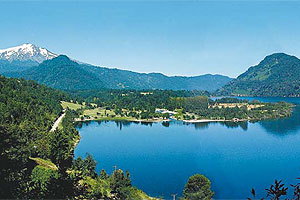The most important economical activities of the Region of los Rios are forestry, services and tourism. Also, it is included amongst the most relevant economical trades of the medium and small enterprises related with agriculture and sea extracted products.
All these activities contribute to the regional PIB (Net Internal Product), which reaches approximately to the 1% of the national total.
Stockbreeding
Accordingly with the figures delivered by the 2007 Forest Census, the Region of los Rios has 854.291,71 hectares stockbreeding bound. The most important cattle is bovine with 621,58 heads, being the Valdivia comuna (county) the one that reported the largest amount of cattle heads.
The importance of stockbreeding is related with the zone’s milk industry, which is an economical activity presenting good projections and considers the development of research besides the investment growth.
On the other hand, ovine cattle have 116,149 head of cattle and pig cattle have 34,297 heads. In a lower amount, raising other animals also takes place in the region, such as equine, goats, camelids and recently, warthogs, deer and rabbits.
Farmland
The total sown land of the region of los Rios amounts to 979,291.59 hectares. The land destined to forage is the most important with 66,882.60 hectares, then comes the land used for cereals with 21,671.80 hectares.
Fruit is grown on a significant amount of hectares (5,034.30), as well as legumes and tubers (3,995.20) and industrial crops (2,265.20).
The sown land taken up by vegetable gardens amounts to 1,727 hectares.
Forest sector
Silviculture is one of the most important areas for the regional economy. This, because it counts with 659,415.31 hectares of surface destined to forest exploitation, and the activity that takes place around this resource provides 3% of the national GDP. This number has remained stable for the last five years.
A few of the most planted forest species are Monterey pine (97,102.10 hectares), eucalyptus (97,213.30 hectares) and Douglas fir (4,369.10 hectares).
Among the native species, one may find the rauli (1,229 hectares), the coigüe (1,533.90 hectares) and the oak tree (607.50 hectares).
The forest industry of the region is devoted to the exploitation of trees to produce lumber and pulp, among other products. In 2005, when this entire area was a province of the region of los Lagos, the production of lumber reached 592,408 m3.
Energy
The region of los Rios has one thermoelectric plant and two hydroelectric ones, both of which make a contribution to the Central Interconnected System (SIC). Pullinque hydroelectric plant has been functioning in Panguipulli since 1962 and its total power reaches 48.6 MW.
Pilmaiquen hydroelectric plant is located in Rio Bueno and began functioning between 1944 and 1959. Its total power amounts to 39 MW.
Valdivia thermoelectric plant is found in the regional capital and has been working since 2004, with a total power capacity of 61 MW.
Likewise, there are projects seeking to take advantage of the region’s energy resources relating to fresh water sources and the geothermal energy generated by volcanoes, in addition to biomass residues generated by the forest industry.
Exports
The products that are exported from the region of los Rios are raw materials or semi-elaborated goods. Among these, pulp stands out as one of the star products of the forest industry.
Likewise, there is currently an increase regarding the export of farming products thanks to the support given to this area’s companies. Among the fruit that presents the best perspectives for the future are rosehip and murta. A similar thing happens with the products that are grown free of potentially harmful chemical elements. This characteristic of production –still performed at a limited level- has allowed for entry into ore demanding markets, like the United States.
When it comes to the regional production of cattle, cow milk and vegetables, they have a domestic destination, specifically, the Metropolitan region.








 Muere Evita
Muere Evita